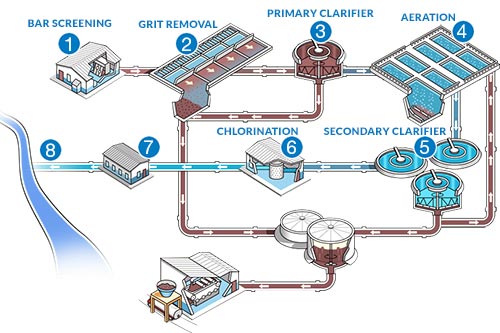The Ultimate Guide To In Home Water Filter Systems
Table of ContentsUnknown Facts About In Home Water Filter SystemsOur In Home Water Filter Systems StatementsIn Home Water Filter Systems for DummiesSome Known Factual Statements About In Home Water Filter Systems
A phosphorous compound is included in help manage rust of pipelines. This helps protect against lead as well as copper that might be existing in pipelines from leaching into the water. As the water leaves the plant, ammonia is added to transform the chlorine to chloramine, an anti-bacterial that maintains a residual in the circulation system versus microbial contamination.All chemicals that are included are accredited food grade, safe for use in foods. Treated water is kept in deep below ground tanks as well as additionally streams by gravity to pumping terminals and also into the circulation system. The distribution system includes 1,960 miles of water mains ranging in size from 4" to 60".
Elimination of taste and also smell compounds from the water.: Softens the water.: Filtering to eliminate little bits and also sanitation to kill viruses and germs, and also guarantee an improper setting for infection as well as bacteria development throughout the circulation system.
Eight Phases of the Wastewater Refine Phase One Bar Testing Elimination of big items from the influent to avoid damages to the center's pumps, valves as well as other devices. The process of treating and also redeeming water from wastewater (any water that has actually been utilized in houses, such as flushing toilets, washing recipes, or showering, as well as some water from commercial usage and also tornado drains) starts with the assumption that after it is treated it will certainly be clean adequate to reenter the atmosphere.
The Single Strategy To Use For In Home Water Filter Systems
According to the EPA, The Clean Water Act (CWA) establishes the standard framework for managing discharges of pollutants into the waters of the United States and also managing top quality criteria for surface area waters. Under the CWA, EPA establishes wastewater standards for market. The EPA has actually likewise created national water quality criteria recommendations for contaminants in surface area waters (in home water filter systems).

Associated White Papers Select Products Stage 2 Screening Elimination of grit by streaming the influent over/through a grit chamber. Great grit that discovers its method into the influent needs to be removed to stop the damages of pumps and also tools downstream (or impact water flow). As well small to be evaluated out, this grit requires to be removed from the grit chamber.
Phase Four Aeration Air is pumped into the aeration tank/basin to encourage conversion of NH3 to NO3 and also supply oxygen for germs to remain to multiply and grow. When transformed to NO3, the germs remove/strip oxygen molecules from the nitrate particles and also the nitrogen (N) is emitted as N2 (nitrogen gas).
This starts in the oygenation tank. The primary feature of the aeration container is to pump oxygen right into the tank to urge the malfunction of any type of natural product (and also the growth of the bacteria), as well as guarantee there is adequate time for the organic product to be damaged down.
Not known Details About In Home Water Filter Systems

Phase Five Secondary Clarifier Treated wastewater is pumped into a secondary clarifier to permit any type of staying natural sediment to settle out of cured water flow. As the influent departures the oygenation process, it moves into a second clarifier where, like the primary clarifier, any type of really tiny solids (or fines) sink to the base of the tank.
Component of this turned on sludge is returned to the oygenation container to raise the microbial focus, aid in proliferation, as well as speed up the break down of organic material. The unwanted is thrown out. The water that streams from the additional clarifier has actually substantially reduced organic product as well as should be coming close to anticipated effluent requirements.
With the enhanced concentration of bacteria as part of the aeration stage, there is a requirement to evaluate the outgoing effluent for bacteria existence or absence as well as to disinfect the water. This makes certain that greater than specified concentrations of microorganisms are not released right into the environment. Chlorination is the most common as well as affordable kind of sanitation however ozone as well as UV sanitation are additionally enhancing in appeal.
A Biased View of In Home Water Filter Systems
Water is routed from the Head Storage Tank to the Claricone clarifier. in home water filter systems. Water enters the clarifier at the mixing area located in the bottom of the Claricone. Lime is added to the water in this zone where it responds with the calcium and webpage also the magnesium in the water to develop speeds up.
After enough time, fragments stick to each various other and grow right into bigger particles, or, floc, which is susceptible to work out in water. Clarification of water is achieved by the seperation of suspended solids from water by gravity.
The cleared up water moves up slowly, at some point overlooking the effluent dam to the cone electrical outlet as well as on the to filters for further treatment. The water plant incorporates a single phase lime softening operation to get rid of hardness. Solidity is triggered by the existence of dissolved bivalent as well as polyvalent metal ions, mostly calcium and magnesium.
This is added both in the clearwell and the high service discharge as water enters the distribution system (in home water filter systems). Hydrofluosilicic over here acid supplies the source of fluoride, which is helpful in the avoidance of dental cavity in youngsters. A fluoride focus of 1. 1-1. 2 mg/l is generally preferable in the plant faucet.